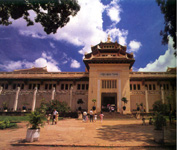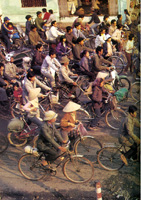- Hanoi
- Hue
- Saigon
- Map of Vietnam

 Built on the site of an ancient Khmer city, Ho Chi Minh City (Saigon) was a thinly populated
area of forests, swamps and lakes until the 17th century. By the end of the 18th century,
Ben Nghe, as the area was known, had become an important trading centre within the region.
Built on the site of an ancient Khmer city, Ho Chi Minh City (Saigon) was a thinly populated
area of forests, swamps and lakes until the 17th century. By the end of the 18th century,
Ben Nghe, as the area was known, had become an important trading centre within the region.
Different theories expound on the origins of the name Saigon, Some say it derives from the former name Sai Cao, a transcription of the Khmer words, Prei Kor, the Kapok Tree Forest Prei Nokor, the forest of the Kingdom, in reference to the Cambodian Vice Roi's residence which has located in the region of present-day Cholon.
In 1859 French and Spanish ships penetrated Saigon. The French unloaded troops and weapons and embarked upon their conquest of the country. Saigon was captured later the same year and became the capital of the French colony of Cochinchina a few years later.
 After the division of the country in 1954, Saigon became the capital of the Republic of
South Vietnam until it fell to the communists in May 1975. The revolutionaries renamed
it Ho Chi Minh City, yet to most of its 5 million inhabitants, the city remains Saigon.
After the division of the country in 1954, Saigon became the capital of the Republic of
South Vietnam until it fell to the communists in May 1975. The revolutionaries renamed
it Ho Chi Minh City, yet to most of its 5 million inhabitants, the city remains Saigon.
Today, 50 miles inland from the coast, Saigon, Vietnam's largest city and river port, sprawls across an area of 761 square miles on the right bank of the Saigon River. The city is divided into 12 urban and six rural districts.
In a sense the French presence remains, lingering not only in the minds of the older generation but physically in the legacy of colonial architecture, long tree lined avenues, streets and highways they left behind.
